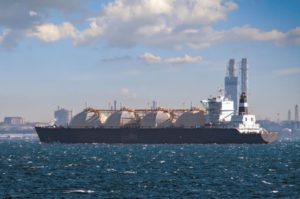
Liquefied Natural Gas Terminals in LA, TX, and OR Could Emit 46 Million Tons of Greenhouse Gases a Year, as Much as 10 Coal-fired Power Plants
Washington, D.C. – At least 10 proposed liquefied natural gas (LNG) export projects that have been approved for construction by regulators are now delayed by at least a year, as companies confronted by both the COVID-19 recession and the oversupply of natural gas have postponed final investment decisions.
The analysis is based on corporate announcements and regulatory decisions to delay construction starts reviewed by the nonprofit Environmental Integrity Project (EIP) in a new report released today, titled “Troubled Waters for LNG.”
These 10 projects with known delays include six new LNG terminals and four expansions, most along the Gulf Coast of Texas and Louisiana, with one new terminal proposed for Oregon. The projects have the potential to emit nearly 46 million tons of greenhouse gases a year — as much as ten large coal-fired power plants or nine million additional cars and trucks on America’s roads, according to the EIP report.
“Rock-bottom energy prices and persistent oversupply jeopardized numerous proposed LNG export terminals before the pandemic, and now their viability is even more tenuous,” said EIP Research Analyst and report author Alexandra Shaykevich. “At the very least, it’s likely that these projects will be postponed by several years. Some should really not be built at all, because they are unnecessary and would add a large amount of air pollution to vulnerable local communities.”
LNG is natural gas that has been cooled to a liquid state, allowing it to be exported on tankers to overseas markets that would otherwise be inaccessible through pipeline transport.
All of the LNG projects discussed in EIP’s report have required approvals from the Federal Energy Regulatory Commission or have final Clean Air Act construction permits from state agencies. Six of the projects, including four new export terminals and two expansion projects, have federal Clean Air Act permits that were issued more than three years ago. And two of these projects had permits whose extensions expired this year. In Jefferson County, Texas, the Port Arthur LNG terminal’s permit extension expired on August 17 In Calcasieu Parish, Louisiana, the Magnolia LNG terminal’s extension expired on September 21.
“Federal and state agencies should withdraw permit approvals for these projects, since they look increasingly speculative, we have cleaner energy choices, and these projects would dump tons of additional pollution on communities that are already struggling,” said Eric Schaeffer, Executive Director of EIP and former Director of Civil Enforcement at EPA. “Once a company receives a Clean Air Act permit, the law says they are supposed to begin construction within a reasonable period of time, usually 18 months. But many of these plants got their original permits three or more years ago and have yet to break ground.”
On top of these 10 LNG projects with known delays of at least a year (because companies have failed to make final investment decisions expected by now) are another 7 projects with permits for construction whose status is unclear. In these cases, they have received federal or state authorizations within the last 18 months. But no construction has begun, and final investment decisions by the companies are not expected until later in 2020 or in future years.
If all 17 of these proposed projects move ahead, they could emit over 67 million tons of greenhouse gases per year, according to their state permits and federal environmental impact statements. They would also release, into local communities that are often lower income and minority, up to 4,000 tons per year of microscopic soot or particulate matter (which can trigger asthma and heart attacks), as well as 17,900 tons of nitrogen oxides and 27,000 tons of volatile organic compounds (both of which contribute to smog), 1,200 tons of sulfur dioxide (which can damage the lungs), and 42,300 tons of carbon monoxide (which can inhibit oxygen intake to the heart and brain).
The majority of proposed terminals are planned for the Texas and Louisiana Gulf Coast, which is vulnerable to hurricanes and coastal flooding that are being made worse by greenhouse gas pollution.
“The LNG terminals proposed for Louisiana sacrifice our health and the very existence of our coast for the worthless goal of exporting gas,” said Anne Rolfes, Director of the Louisiana Bucket Brigade. “We are an impoverished state, and these projects built in flood zones make us poorer and more vulnerable. Hurricane Laura is an example of what foolish projects these are because the ocean inundated the sites during the storm.”
John Beard, Chair of the Port Arthur Community Action Network in Texas, said: “We have a saying here in Port Arthur, ‘you can’t add by subtraction.’ You can’t improve the condition of the air by adding yet another company with more air pollution, while making no actual reductions in emissions. We are already surrounded by refineries and other source of air pollution.”
Catherine Fraser, Clean Air Associate for Environment Texas, said: “As we work to address the COVID-19 and climate crises, we need to shut down these super polluting facilities that increasingly threaten our air, our water, and our climate. No Texan should have to worry about toxic air pollution compounding ongoing threats of the coronavirus and climate change.”
Key Findings of This Report:
- Before the pandemic, the industry had been expanding dramatically, with six U.S. export terminals operating. In addition to this, state and federal regulators authorized companies to build 17 new LNG terminals or expansions. These have not yet been built, but have the potential to emit over 67 million tons of greenhouse gases per year, more climate-warming pollution than is released from 16 coal-fired power plants operating around the clock for a year.
- Included in these 17 authorized projects are 10 with known delays of at least a year. These delayed projects – six new terminals and four expansions – could release up to 45.6 million tons per year of greenhouse gases, as much as 10 coal fired power plants.
- LNG terminals also are reliant on supporting infrastructure, such as pipelines and compressor stations. Compressor stations alone could add more than 8 million tons of greenhouse gases to the LNG sector’s emissions footprint.
- Construction of LNG terminals and their associated pipelines and compressors could harm local air quality by stirring up particulate matter in the short-term and release nearly 11 million tons of greenhouse gases over three to eight years.
- Many of these massive projects would release tons of potentially health-damaging air pollutants in minority communities. About 38 percent of the people living within three miles of proposed LNG facilities are people of color and Hispanics or Latinos, and 39 percent are low income (defined as households earning less than $24,120 annually).
EIP’s report makes the following recommendations:
- Several studies have shown that long-term exposure to air pollution increases the risk of illness or death from COVID-19. Local and state permitting authorities need to carefully consider the added health risks of proposed projects during this unprecedented public health crisis. Because communities of color and low-income populations are more likely to live near industrial facilities and other major pollution sources, policymakers also need to consider the disproportionate health burden they bear when approving permits.
- The natural gas industry has been struggling for years to finance proposed projects as a result of chronic oversupply, depressed energy prices, and public opposition. Despite the challenging economic climate, policymakers have continued to offer tax breaks and government incentives to risky LNG projects that threaten air quality while locking-in future demand for fossil fuels. Regulators need to take market realities into account, and stop allowing oil and gas companies’ volatile financing schedules to dictate project planning.
- The federal Clean Air Act requires facilities to begin construction within a reasonable amount of time after receiving the necessary permit approvals. State environmental agencies should cancel permits issued more than three years ago, given the significant impacts these projects have on global warming and local air quality, and the shrinking global demand for LNG. Regulators should also defer approvals of any more permit applications.
The Environmental Integrity Project is a nonprofit, nonpartisan organization based in Washington, D.C., and Austin, Texas, that protects public health and the environment by investigating polluters, holding them accountable under the law, and strengthening public policy.
Media contact:
Tom Pelton, Environmental Integrity Project, (443) 510-2574 or tpelton@environmentalintegrity.org


